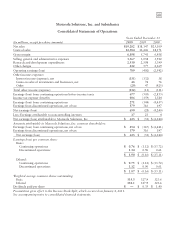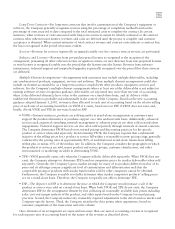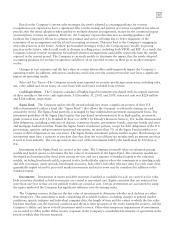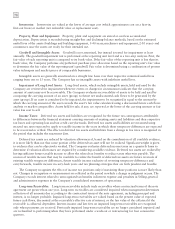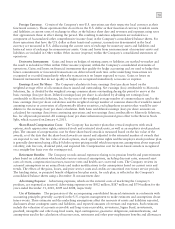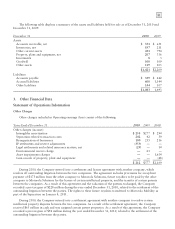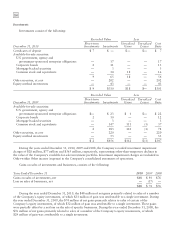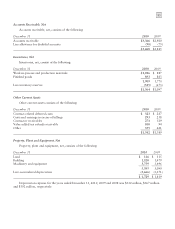Motorola 2010 Annual Report Download - page 87
Download and view the complete annual report
Please find page 87 of the 2010 Motorola annual report below. You can navigate through the pages in the report by either clicking on the pages listed below, or by using the keyword search tool below to find specific information within the annual report.
79
Foreign Currency: Certain of the Company’s non-U.S. operations use their respective local currency as their
functional currency. Those operations that do not have the U.S. dollar as their functional currency translate assets
and liabilities at current rates of exchange in effect at the balance sheet date and revenues and expenses using rates
that approximate those in effect during the period. The resulting translation adjustments are included as a
component of Accumulated other comprehensive income (loss) in the Company’s consolidated balance sheets. For
those operations that have the U.S. dollar as their functional currency, transactions denominated in the local
currency are measured in U.S. dollars using the current rates of exchange for monetary assets and liabilities and
historical rates of exchange for nonmonetary assets. Gains and losses from remeasurement of monetary assets and
liabilities are included in Other within Other income (expense) within the Company’s consolidated statements of
operations.
Derivative Instruments: Gains and losses on hedges of existing assets or liabilities are marked-to-market and
the result is included in Other within Other income (expense) within the Company’s consolidated statements of
operations. Gains and losses on financial instruments that qualify for hedge accounting and are used to hedge firm
future commitments or forecasted transactions are deferred until such time as the underlying transactions are
recognized or recorded immediately when the transaction is no longer expected to occur. Gains or losses on
financial instruments that do not qualify as hedges are recognized immediately as income or expense.
Earnings (Loss) Per Share: The Company calculates its basic earnings (loss) per share based on the
weighted-average effect of all common shares issued and outstanding. Net earnings (loss) attributable to Motorola
Solutions, Inc. is divided by the weighted average common shares outstanding during the period to arrive at the
basic earnings (loss) per share. Diluted earnings (loss) per share is calculated by dividing net earnings (loss)
attributable to Motorola Solutions, Inc. by the sum of the weighted average number of common shares used in the
basic earnings (loss) per share calculation and the weighted average number of common shares that would be issued
assuming exercise or conversion of all potentially dilutive securities, excluding those securities that would be anti-
dilutive to the earnings (loss) per share calculation. Both basic and diluted earnings (loss) per share amounts are
calculated for earnings (loss) from continuing operations and net earnings (loss) attributable to Motorola Solutions,
Inc. for all periods presented. All earnings (loss) per share information presented gives effect to the Reverse Stock
Split, which occurred on January 4, 2011.
Share-Based Compensation Costs: The Company has incentive plans that reward employees with stock
options, stock appreciation rights, restricted stock and restricted stock units, as well as an employee stock purchase
plan. The amount of compensation cost for these share-based awards is measured based on the fair value of the
awards, as of the date that the share-based awards are issued and adjusted to the estimated number of awards that
are expected to vest. The fair value of stock options, stock appreciation rights and the employee stock purchase plan
is generally determined using a Black-Scholes option pricing model which incorporates assumptions about expected
volatility, risk free rate, dividend yield, and expected life. Compensation cost for share-based awards is recognized
on a straight-line basis over the vesting period.
Retirement Benefits: The Company records annual expenses relating to its pension benefit and postretirement
plans based on calculations which include various actuarial assumptions, including discount rates, assumed asset
rates of return, compensation increases, turnover rates and health care cost trend rates. The Company reviews its
actuarial assumptions on an annual basis and makes modifications to the assumptions based on current rates and
trends. The effects of the gains, losses, and prior service costs and credits are amortized over future service periods.
The funding status, or projected benefit obligation less plan assets, for each plan, is reflected in the Company’s
consolidated balance sheets using a December 31 measurement date.
Advertising Expense: Advertising expenses, which are the external costs of marketing the Company’s
products, are expensed as incurred. Advertising expenses were $502 million, $387 million and $754 million for the
years ended December 31, 2010, 2009 and 2008, respectively.
Use of Estimates: The preparation of the accompanying consolidated financial statements in conformity with
accounting principles generally accepted in the U.S. requires management to make estimates and assumptions about
future events. These estimates and the underlying assumptions affect the amounts of assets and liabilities reported,
disclosures about contingent assets and liabilities, and reported amounts of revenues and expenses. Such estimates
include the valuation of accounts receivable and long- term receivables, inventories, Sigma Fund, investments,
goodwill, intangible and other long-lived assets, legal contingencies, guarantee obligations, indemnifications, and
assumptions used in the calculation of income taxes, retirement and other post-employment benefits and allowances


